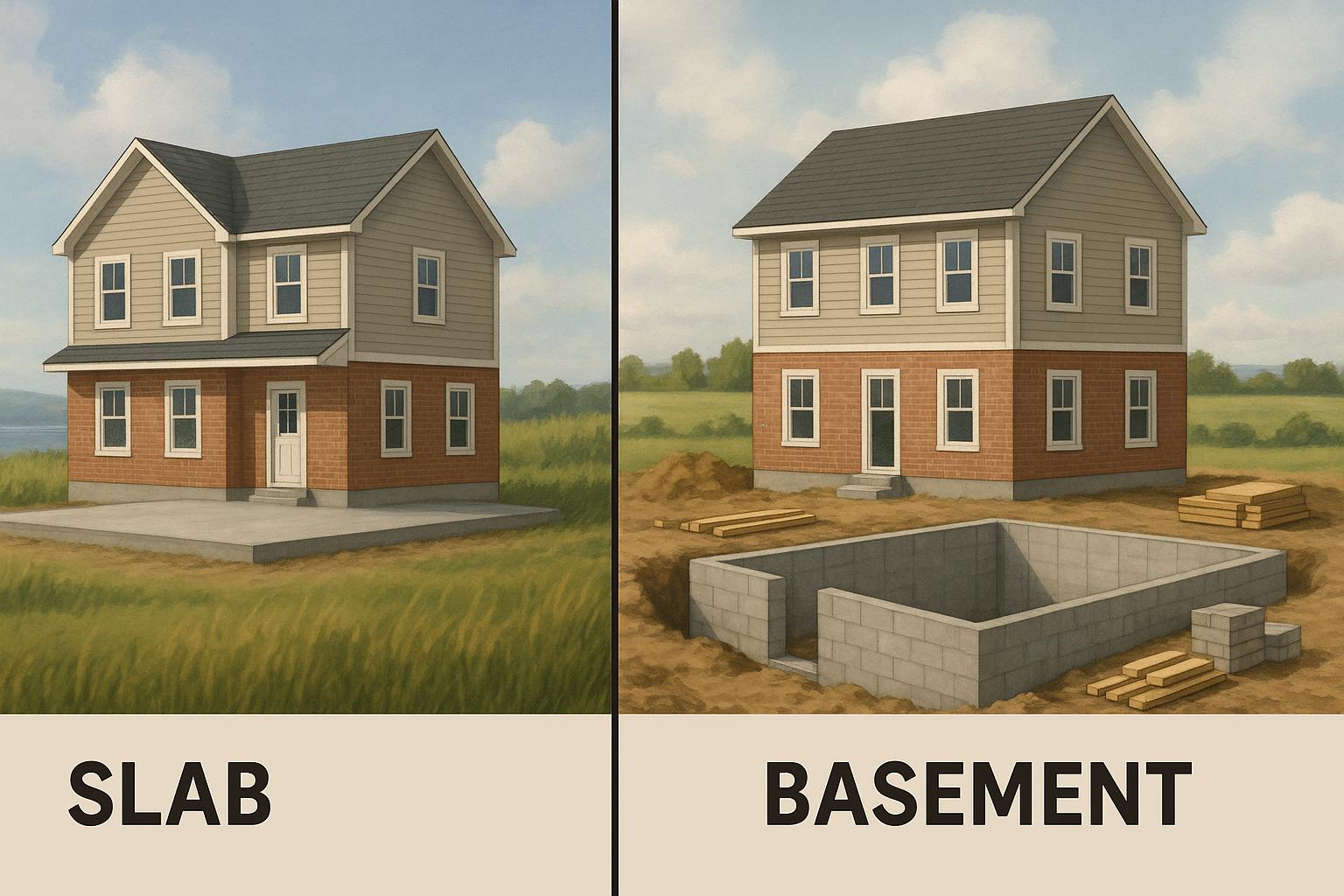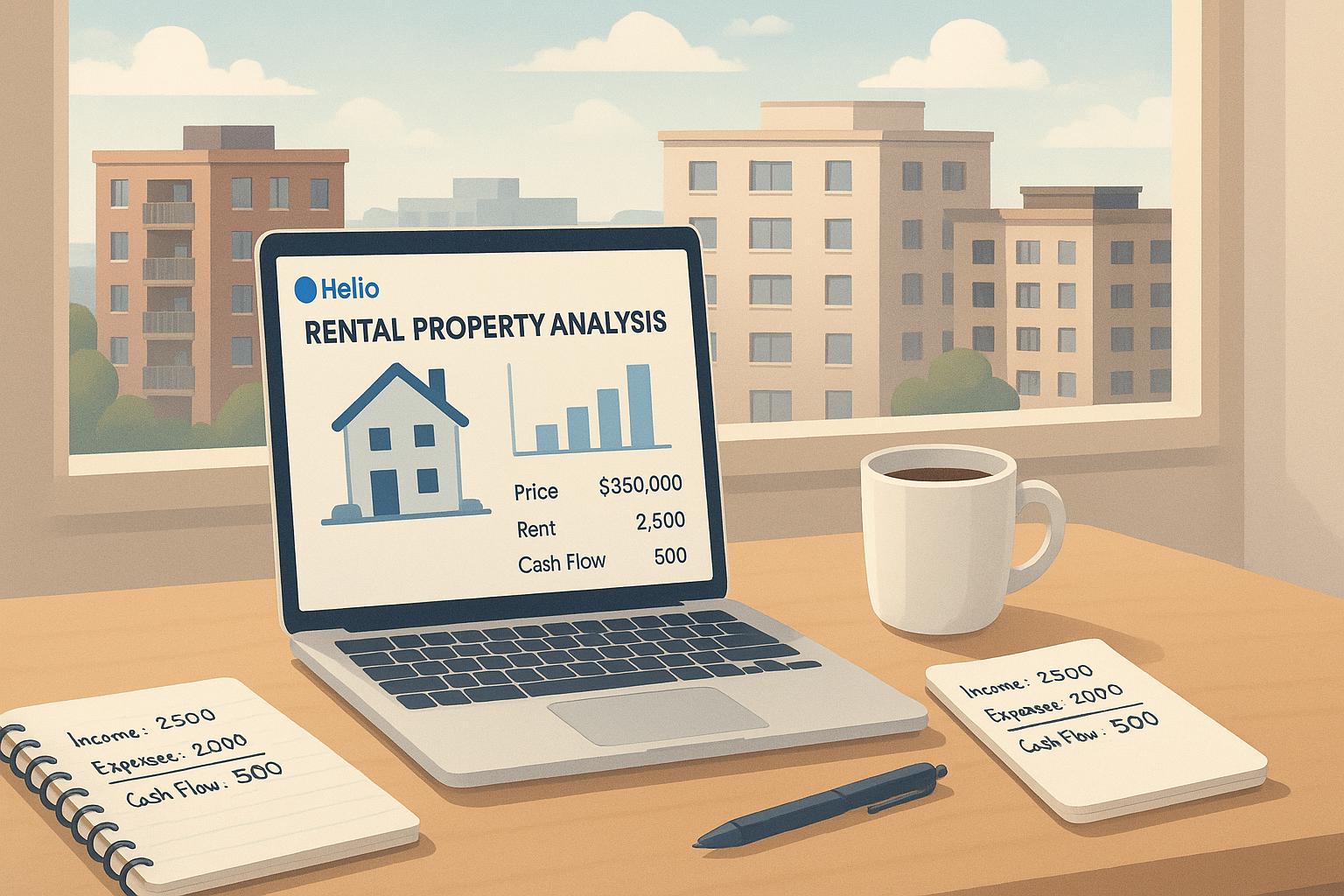Building a home in Nova Scotia? Here's the quick breakdown:
- Cost: Prefab homes start at $168/sq. ft, while custom homes range from $175–200/sq. ft. Prefab is often cheaper but adds transportation costs.
- Timeline: Prefab homes are faster, taking 4–6 months, compared to 9–12 months for custom homes.
- Quality: Prefab homes offer consistent factory-controlled quality, while custom homes provide more design flexibility and on-site adjustments.
- Weather Impact: Nova Scotia's harsh weather makes prefab builds more predictable, as construction happens indoors. Custom builds face delays due to weather.
- Design: Prefab homes allow limited customization, while custom homes offer unlimited design possibilities.
Quick Comparison Table
| Factor | Prefab Homes | Custom Homes |
|---|---|---|
| Cost | $168–185/sq. ft + transport | $175–200/sq. ft |
| Timeline | 4–6 months | 9–12+ months |
| Design Flexibility | Limited | Unlimited |
| Weather Impact | Minimal | High |
| Site Preparation | Precise groundwork, crane needed | More adaptable |
Bottom line: Choose prefab for speed and predictable costs. Opt for custom if design flexibility and unique features are your priority.
Custom vs Prefab: Basic Differences
Custom Home Basics
Custom homes in Nova Scotia are built entirely on-site using traditional stick-built construction techniques. This process starts from scratch, with every element - from the foundation to the roof - constructed piece by piece at the site. Homeowners work closely with local builders and architects to create designs that are tailored to their specific needs and preferences.
The construction process involves a variety of tradespeople working in sequence. Framers handle the structural framework, followed by electricians, plumbers, and other specialists who install systems and finishes. This hands-on approach allows for real-time adjustments, giving homeowners the freedom to make design changes as the build progresses. On the other hand, prefab methods take a very different approach, offering a more streamlined and factory-driven alternative.
Prefab Home Basics
Prefab homes, in contrast, are largely manufactured off-site. These homes are built in sections, known as modules, within a controlled factory environment. Once completed, the modules are transported to the building site and assembled. Because much of the work is done in the factory, on-site construction time is significantly reduced. This is particularly advantageous in Nova Scotia, where unpredictable weather can complicate traditional builds.
Prefab construction has become increasingly popular in Nova Scotia, largely due to its efficiency and cost-saving potential. The factory setting ensures precise quality control and eliminates weather-related delays - factors that are especially beneficial given the province's often variable climate.
Common Prefab Misconceptions
Modern prefab homes have come a long way, challenging outdated stereotypes about their quality and design. A common misconception is that prefab homes are less energy-efficient. However, as Thomas Mueller, President of the Canada Green Building Council, highlights:
"A phenomenal achievement."
Mike Reynolds from Ecohome adds:
"If you can build a house that costs next to nothing to operate for the same price as building a traditional house, why would you build it any other way?"
Today’s prefab homes deliver:
- Advanced energy-efficient designs
- High structural durability
- Flexible and customizable floor plans
- High-quality materials and construction standards
- Better moisture control due to indoor manufacturing
In Nova Scotia, modern prefab homes are required to meet or exceed the same building codes as custom-built homes. This ensures they are durable enough to withstand the province’s challenging climate. These advancements set the stage for a deeper comparison of cost, timing, and overall quality between the two building methods.
Price Breakdown
Prefab Home Costs
Prefab homes start at $168 per square foot for single-family residences. The lower costs are made possible by factory production, which offers several advantages:
- Buying materials in bulk
- Minimizing waste
- Streamlining production processes
- Reducing labour expenses through efficient assembly methods
However, the final price can vary due to additional factors:
- Transportation Costs: Delivering prefab modules to a property in Nova Scotia can be expensive, especially for remote locations or sites with limited access.
- Site Preparation: Prefab homes require precise groundwork, including:
- Accurate foundation work to fit modular sections
- Crane rentals for placing the modules
- Utility connections and finishing touches
These costs differ from those of traditional custom building, which involves its own unique pricing structure.
Custom Home Costs
Custom-built homes in Nova Scotia typically range from $175 to $200 per square foot, covering:
- Materials
- Labour
- Management fees
- Potential weather-related delays
Custom builds also come with unique cost factors, such as:
- Fluctuations in material prices
- Design changes during construction
- Challenges specific to the building site
Cost Comparison Chart
Here’s a side-by-side look at the key cost factors for prefab and custom homes:
| Cost Factor | Prefab Home | Custom Home |
|---|---|---|
| Base Price (per sq ft) | $168–185 | $175–200 |
| Site Preparation | $15,000–25,000 | $12,000–20,000 |
| Transportation | $8,000–15,000 | - |
| Design Changes | Limited, higher cost | Flexible, moderate cost |
| Weather Impact | Minimal | 5–15% cost increase |
| Foundation Costs | $25,000–35,000 | $20,000–30,000 |
Long-Term Considerations
Both prefab and custom homes come with potential hidden costs, such as variable site expenses and ongoing maintenance. However, they offer distinct long-term benefits:
- Prefab Homes: Predictable pricing and faster construction timelines can help speed up income generation, making them appealing for investors.
- Custom Homes: Greater flexibility in design and adaptability to unique sites can enhance long-term value, especially for those with specific aesthetic or functional goals.
For investors, prefab homes are ideal for quick project completion and generating rental income. On the other hand, custom builds are better suited for those looking to tailor their home to meet unique needs or site challenges.
Construction Timelines
Prefab Build Speed
Prefab homes are known for their efficiency, typically reaching completion within 4 to 6 months. This speed is achieved by manufacturing the modules in a controlled factory environment while simultaneously handling site preparation. This parallel process helps avoid delays caused by unpredictable weather.
Custom Build Duration
Custom homes, on the other hand, take a more traditional approach. Built step by step on-site - starting with the foundation, followed by framing, and then finishing - these projects usually span 9 to 12 months or even longer. Delays often arise from fluctuating contractor schedules and material delivery issues.
Weather Effects on Build Time
Nova Scotia's weather can significantly impact construction timelines. Cold and rainy conditions often slow down exterior work and make concrete pouring difficult, adding extra time to custom builds. Prefab construction, however, avoids many of these setbacks since most of the work happens indoors. For anyone building in Nova Scotia, understanding these differences can help navigate the province's unique challenges.
Build Quality and Design Options
Prefab Quality Standards
Prefab homes today are built with an impressive level of precision, thanks to controlled factory environments. These facilities follow strict quality control measures, ensuring that materials are protected from Nova Scotia's unpredictable weather. Each stage of construction is carefully inspected, and modules are rigorously tested before they leave the factory. This process not only meets but often exceeds Nova Scotia's building codes. Plus, building in a controlled environment minimizes moisture-related problems like mould, which can be a major concern in traditional on-site construction.
"If you can build a house that costs next to nothing to operate for the same price as building a traditional house, why would you build it any other way?" - Mike Reynolds, Ecohome [1]
This level of reliability in prefab construction sets the foundation for understanding how it compares to the creative possibilities of custom-built homes.
Custom Design Options
Custom homes, on the other hand, shine when it comes to design flexibility. Homeowners can collaborate directly with architects to bring their dream home to life. From crafting unique floor plans to specifying room sizes and picking premium materials, the options are virtually endless. This freedom extends to architectural elements like vaulted ceilings, custom window placements, and even specialized spaces tailored to personal needs. While this level of customization requires more coordination and planning, it results in homes that are truly one of a kind, reflecting the owner's vision and lifestyle.
Here's a quick comparison of the main differences between prefab and custom homes in terms of quality and design:
| Aspect | Prefab Homes | Custom Homes |
|---|---|---|
| Quality Control | Factory-controlled, standardized processes | On-site supervision, weather-dependent |
| Design Flexibility | Pre-designed modules with limited customization | Unlimited design possibilities |
| Material Selection | Standard options with some room for changes | Complete freedom of choice |
| Weather Protection During Build | Fully protected in factory setting | Exposed to the elements during construction |
| Environmental Standards | Can achieve high certifications (e.g., LEED V4 Platinum) [1] | Depends on builder expertise and materials |
| Construction Oversight | Multiple quality checks in the factory | Individual inspections throughout the build |
Both prefab and custom homes can deliver excellent results when handled by skilled builders or manufacturers. The main difference lies in the construction process and the level of design freedom. Prefab homes are ideal for consistent quality and weather-protected construction, while custom homes offer unmatched creative control and material options.
sbb-itb-16b8a48
Nova Scotia Building Factors
Weather Protection Standards
Nova Scotia's climate can be tough, with strong winds, salty air, and freezing winters putting buildings to the test. Both prefabricated and custom homes are designed to meet local codes for severe weather conditions. Prefab homes, built in controlled indoor environments, ensure consistent quality, while custom homes can be tailored to the specific needs of the site, such as reinforced foundations or improved drainage systems. Beyond material durability, the logistics of construction - like timing and efficiency - can also impact the overall building process.
Site Access and Transport
The province's varied landscape often makes transport and site access a key consideration. Prefab modules, while efficient, can be tricky to move along narrow or steep roads. On the other hand, custom builds rely on smaller, more flexible material shipments, which are easier to handle in challenging locations. However, custom builds may require multiple deliveries, potentially stretching timelines - especially in winter when road conditions can slow progress.
Investment Returns
Weather resilience and logistics are just part of the equation when weighing the financial side of your build. Prefab homes, with a fixed cost of $168 per square foot, provide clear pricing and quicker construction timelines, making it easier to plan for returns on investment. Custom builds, while potentially offering unique design advantages, often come with higher and less predictable costs, which can influence ROI. These financial factors, combined with earlier considerations around time and durability, play a big role in choosing the best approach.
| Factor | Prefab Impact | Custom Impact |
|---|---|---|
| Initial Cost | Fixed pricing from $168/sq.ft | Higher and less predictable costs |
| Construction Time | Faster build times, earlier occupancy | Longer timelines, affecting ROI |
| Maintenance | Standardized systems for easier upkeep | Unique features may need specialized care |
| Resale Value | Steady market performance | Potential for higher value with unique designs |
| Insurance Rates | Stable rates due to consistent build quality | Rates may vary based on custom features |
Making Your Choice
Main Decision Points
When deciding between prefab and custom construction, there are three key factors to weigh:
Budget Control: Helio Urban Development offers fixed pricing for prefab builds, starting at $168 per square foot. This makes costs more predictable compared to custom builds, which can fluctuate due to material choices and weather-related delays.
Timeline Requirements: If you're aiming for quicker occupancy, prefab construction is a strong contender. Its factory-controlled process keeps things moving regardless of weather. On the other hand, custom builds allow for more on-the-fly adjustments, though they typically take longer.
Site Considerations: The nature of your property plays a big role. Prefab modules require easy access and stable terrain for delivery and installation. Custom builds, however, can adapt more easily to rocky landscapes or locations with limited access.
These factors help shape the overall approach to your project. They build on earlier discussions about cost and timelines, highlighting the variables that will most impact your decision.
| Factor | Best Choice When... |
|---|---|
| Budget | Prefab: Predictable costs and financing are key. |
| Custom: You're aiming for premium, unique designs. | |
| Timeline | Prefab: Speed is a top priority. |
| Custom: Flexibility matters more than speed. | |
| Location | Prefab: The site has easy access and stable terrain. |
| Custom: The site is challenging or hard to access. |
Decision Guidelines
To make the best choice, consider these steps:
Assess your property’s conditions: Look at access, terrain, and how exposed the site is to weather. Prefab may not be ideal for hard-to-reach locations.
Set a clear timeline: If you need to move in within 4-6 months, prefab is your best bet. Custom builds usually take at least 9-12 months.
Identify your must-haves: For unique designs or highly personalized features, custom construction is the way to go. If efficiency and standardization are more important, prefab is the smarter option.
Account for total costs: Beyond base pricing, don’t forget site preparation, foundation work, and utility hookups. While prefab provides clear upfront pricing, additional site-specific expenses can still affect your overall budget.
Which is Better: Modular Home VS Traditional Home Construction
FAQs
What unexpected costs should I consider when building a prefab or custom home in Nova Scotia?
When planning to build a prefab home in Nova Scotia, it’s important to consider hidden costs that might not be immediately obvious. For example, you’ll need to account for transporting the modules to your site, preparing the foundation, and hooking up utilities like plumbing and electricity. These costs can climb even higher if your site is in a remote location.
If you’re going the custom home route, unexpected expenses can pop up for different reasons. Weather-related delays are a common issue, especially during Nova Scotia’s tough winters. On top of that, material and labour costs can fluctuate, and working with multiple subcontractors often brings added charges if schedules don’t align.
To stay ahead of the game, it’s smart to set aside a contingency fund in your budget - whether you’re opting for a prefab or custom home. It’s better to prepare for the unexpected than to be caught off guard.
How does Nova Scotia’s weather affect the construction and durability of prefab and custom homes?
Nova Scotia's challenging weather - think snow, strong winds, and those relentless freeze-thaw cycles - has a big impact on how homes are built and how long they last. When it comes to construction timelines, prefab homes hold a clear edge during the winter. Since their components are built indoors in a controlled setting, there’s less chance for weather to throw a wrench in the schedule. On the other hand, custom homes, built entirely on-site, can be delayed by snowstorms or freezing temperatures, often stretching out the timeline.
As for durability, both prefab and custom homes can handle Nova Scotia’s tough climate if designed and built properly. Prefab homes are crafted to meet Canadian building codes and are often constructed with a level of precision that helps them stand up to harsh conditions. Similarly, custom homes, when built by experienced professionals, can be tailored with the right materials and designs to tackle challenges like high winds and salty air. In the end, whether you go prefab or custom, a well-executed build can result in a sturdy, weather-resistant home that stands the test of time.
What are the long-term investment advantages of choosing a prefab home over a custom-built home in terms of resale value and maintenance in Nova Scotia?
Prefab homes can present several long-term investment perks when compared to custom-built homes, particularly in Nova Scotia. Modern prefab homes have seen a notable boost in resale value. Built to meet or even exceed local building codes, they now stand on par with traditional homes in the eyes of buyers. Features like energy efficiency and sturdy construction make them especially appealing. That said, resale value still hinges on factors like location, design, and how well the home is maintained.
When it comes to maintenance, prefab homes often come out ahead. Constructed in controlled factory settings, they benefit from consistent build quality, which minimizes the risk of structural problems down the line. Many prefab designs also incorporate energy-efficient materials and systems, which can help cut utility costs and reduce overall wear and tear. However, just like custom homes, regular upkeep and proper care are crucial to preserving their value and functionality over time.



